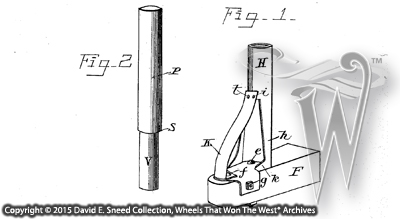Over the years, I’ve regularly sharedthe competitive nature of America’s early wagon builders. The more I’ve researched this industry, themore amazed I am that the cut-throat business tactics and dominant reputationsof many have rarely been reported. Throughoutthe 1800’s and early 1900’s, countless firms went head to head, challenging eachother with price wars, races for single and mass market dominance, control ofraw materials, employment benefits, and innovative engineering. Some even mimicked paint graphics andfabrication styles of competitors in order to sway buyers. From the forest to the factory, a lot of stories from this part of the American West can be just as wild as those from an all-nightsaloon in a frontier mining town.
With tens of thousands of makers and aknown history for some to simulate the construction traits of others, it’sinevitable I suppose that modern day efforts to identify wagon brands can hit asnag from time to time. As a result, I’veregularly cautioned against using only one or two points to assume anidentification is accurate. Toillustrate that counsel a bit more this week, I thought I’d open up our filesand show yet another example of how confusing and problematic evaluations canbecome when we focus on just one notable characteristic.
By all accounts, T.G. Mandt (Stoughton,Wisconsin) was one of America’s most prominent wagon makers. His innovative genius is recorded in numerouspatents granted for wagons and sleighs/sleds. Because the Mandt brand was a dominant and high-profile company, many oftoday’s early vehicle enthusiasts will quickly recognize the hollow-tubed bolsterstake design that Mr. Mandt created in the late 1800’s. What most don’t know, however, is that therewas another patent granted to yet another company for an extremely similardesign.
Below are illustrations from the two (2)different patents. Can you pick out theoriginal design conceived and manufactured by T.G. Mandt? While some might be fortunate to choose thecorrect Mandt design here, looking at a single example on a wagon without paintwould likely be a bit more tricky.
 |
| Can you guess which of these early illustrations belong to the patent awarded to legendary wagon builder, T. G. Mandt? |
Both concepts are so alike in form,feel, and function that, unless a person is well aware of the alternativedesign, it’s tempting to associate each as being the same T.G. Mandt piece. Moral of the story? Caveat Emptor... collectors, buyers, and thosequick-to-judge will do well to take note. There are countless mirrors of innovations and design practices justwaiting to be misread. As with any topic,one way to help avoid misconceptions is to devote oneself to continued growthand experience on the subject.
Ultimately, period wagons are made fromhundreds of parts. Each segment of the whole has a storyto tell related to identity, originality, authenticity, purpose, and even thetimeframe of manufacture. By the sametoken, overlooking any element can easily leave individuals open forembarrassment, frustration, and maybe even a healthy dose of regret. Please Note: As with each of our blog writings, all imagery and text is copyrighted with All Rights Reserved. The material may not be broadcast, published, rewritten, or redistributed without prior written permission from David E. Sneed, Wheels That Won The West® Archives.
